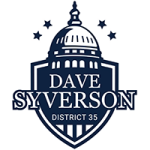SPRINGFIELD – A $50.6 billion stop-gap budget approved by lawmakers on June 30 makes a historic investment in K-12 education, provides money for early childhood education and higher education, funds critical government operations as well as programs and services to help the state’s most vulnerable, protects Illinois taxpayers and provides for no bailout of the Chicago Public Schools (CPS) system.
“Our schools will receive the most money in state history for the coming school year, through a plan that will help all Illinois schools without asking taxpayers to fund a Chicago bailout,” said State Senator Dave Syverson (R-Rockford). “Our stopgap budget will ensure than important human service programs, road construction, and state operations can continue through the fall.”
The short-term budget was designed to make sure K-12 schools open as planned this fall and keep government operating while the Governor and the Legislature continue to work on a full-year, balanced budget with structural reforms that will help grow Illinois’ economy.
Importantly, K-12 education in Illinois will be funded at 100 percent of the foundation level, which is the first time that’s been done in seven years. There is a more than $520 million increase in funding for schools compared to Fiscal Year 2016, which brings the total for elementary and secondary education to $7.2 billion. All school districts, including Chicago, are “held harmless.” There will also be a $250 million equity grant for the poorest school districts in Illinois, which is based on the State Board of Education’s low-income grant formula. As part of the budget package advanced June 30, Chicago Public Schools could receive $215 million “pension parity” in the future, but the grant will not be enacted unless more comprehensive, structural pension reform is passed by the General Assembly.
Additionally, the plan doesn’t include the “bail out” of Chicago Public Schools pushed by the legislative majority during the spring legislative session. Instead, a proposal approved June 30 gives Chicago the power to raise property taxes to help fund Chicago schools.
The stop-gap measure also funds $1 billion to higher education, in addition to $600 million already approved for FY16 this spring. The plan should ensure that universities are able to open on time and complete the full fall semester. The plan includes $151 million in funding for MAP grants for spring semester 2016 and provides community colleges with $114 million, plus funding for adult career tech and other grants.
Included in the stop-gap budget is more than $13 billion for new and ongoing transportation infrastructure improvement and maintenance projects, which will ensure 800 active transportation projects can continue uninterrupted, while also keeping 25,000 workers on the job.
After operating for nearly a year without funding, human service providers not covered by court orders or consent decrees will receive $701 million to get them through the next six months. This includes $35 million in additional human services grants. This funding level means that human services will get more than 90 percent of the amount they typically would get over 18 months when including spending authorized by court orders.
Funding for critical state government operations will include $454 million from GRF, with an additional $275 million from the Rainy Day Fund, which will help cover critical needs at state agencies, including: utilities, food and medical services at state prisons, mental health centers and veterans’ homes. Public safety also benefits as funds are available to make improvements to, and fuel, Illinois State Police vehicles. State Parks would also remain open, and Conservation Police would still be able to patrol waterways.
Fiscal Year 2017 begins Friday, July 1, 2016.

